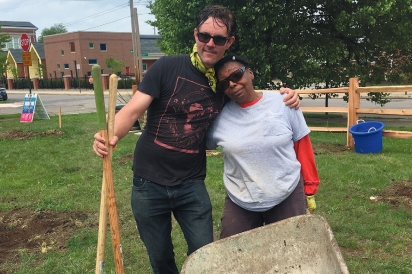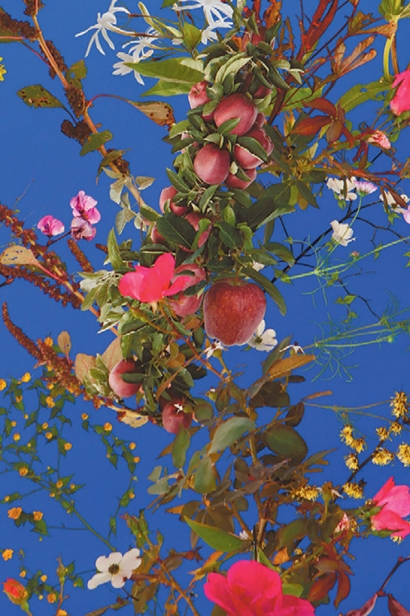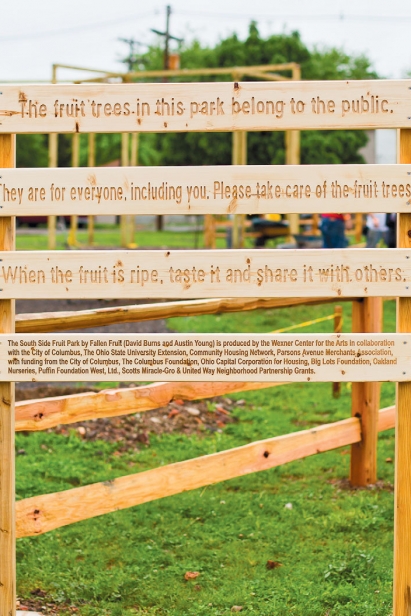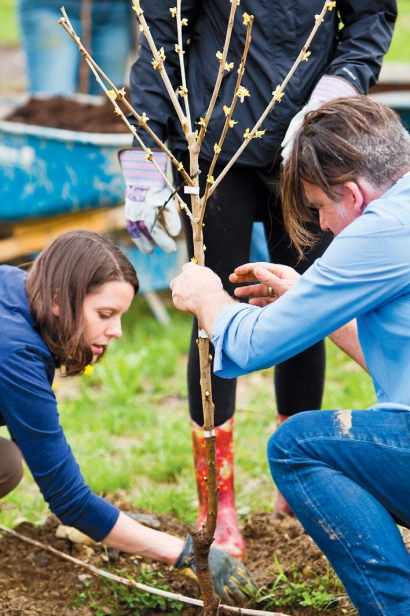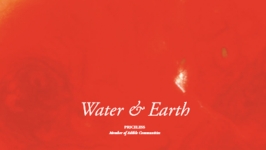South Side Fruit Park Gives the Gift of Fruit
A global art project dedicated to growing fruit parks takes root on the South Side of Columbus
“Fruit is one of the most unusual things in this world,” says Los Angeles-based artist David Burns as we talk, along with his artistic partner, Austin Young, about their ongoing arts collaboration, Fallen Fruit, “because it’s relatable to the smallest child and their great-grandparent, and they’re both experts on the flavor of a strawberry.”
You may not be convinced of how strawberries and pear trees can remedy the ills of a city. It’s hard sometimes to believe in any remedy for the blight on the world these days and the poverty of spirit it creates. Yet artists like David and Austin, and leaders like Shelly Casto, director of education at the Wexner Center for the Arts, and Bob Leighty of the Parsons Avenue Merchants Association, have cast doubt and despair aside for a more noble truth. One of solidarity through food and art.
The Fruit Falls
In October 2015, David and Austin landed in Columbus for an artist talk at the Wexner Center. Around the same time, Bob down on the South Side was percolating with ideas for an edible forest on unused property. Bob grew up around farmland in central Pennsylvania, and so has instilled within his buoyant, charismatic spirit a love of the Earth and her bounty, particularly the strawberries his Uncle James grew.
Cut to Shelly, who, upon remembering former- Mayor Michael Coleman’s charge to focus on developing the community on the South Side, was committed to cross-pollinating David and Austin’s work with an initiative in the neighborhood. Serendipity rained down, and Bob and Shelly were introduced, two star-crossed community advocates on a mission, and the South Side Fruit Park began.
David and Austin travel all over the world installing their fruit parks, where they plant fruit trees and establish parks in cities. The hope: using fruit as a simple means for people to relate and enjoy each other’s company and their neighborhood—a seemingly innovative concept in an age of cellphones and screens, where we spend more time walling ourselves off on our Instagram accounts than connecting with the real people in our lives.
“Fruit trees are a vehicle that we do our work with,” says Austin. “The fruit trees might not necessarily be the artwork, but they’re an in credible connector between people that create a new space for people to connect around in a neighborhood.”
“As contemporary artists, we consider our art practice is bringing people together and making relationships and having an incredible experience with people, or creating space for other people to have that experience,” says David. “When we do a project in a city, that’s what we’re bringing to our work.”
Originally inspired by a quote from the book of Leviticus in the Bible, David and Austin use the term “fallen fruit” for the meaning it suggested then—leave the remainders of fruit on the outsides of fields for the people passing by. Fallen Fruit takes on other forms, like Public Fruit Jams where people come together to make jam from the fruit in the fruit park, museum exhibitions featuring artwork “that explores the social and political implications of our relationship to fruit and world around us,” and curatorial projects where the artists reframe a museum’s collection around the context of local histories that often includes fruit.
Here in Columbus, we’re graced with two fruit parks—one on the South Side by the Reeb Avenue Center, and one in Weinland Park. The first planting was in April of this year, and while the saplings on the South Side are scrawny, they are strong, set to bear fruit in three to five years.
Building Trust
“The South Side needs a little hug,” David says, as we talk about its history and the challenges it’s currently facing. Shelly agrees, the South Side can be rough. She readily admits, however, that through her service to the community, “I fell in love with that neighborhood. I miss seeing those folks as much as I have been over the last year and a half.”
The South Side harbors a history of steel and glass, with Eastern Europeans, African Americans and Appalachians, all working hard to raise their families and earn an honest living. It was a boom and then bust neighborhood, big industry that then went the way of global commerce. During the housing market crisis in 2009, dozens of homes were vacated practically overnight, leaving not just huge factories to sit vacant, but humble homes, too.
It’s this history that David and Austin researched when planning the fruit park. “We don’t want to parachute in and drop off a trinket,” says David, emphasizing how research-heavy their artistic process is. They spent time digging through city archives looking at newspaper clippings and diaries. “Every city has a little magic room,” David says. “Sometimes it’s in people’s homes. It didn’t make it to the institution yet.”
“This park is at the site of the original South Side Settlement House, back a hundred years or so,” says Bob. “We actually are tapped into their old water line for our irrigation system. That history is important, almost as important as our present and our future.”
Yet the more important engagement was with the community leaders and organizations. Both David and Austin and Shelly sat in on regular community meetings over the course of a year and a half to create relationships with people. “It was really interesting to learn Columbus’ history of taking care of each other in these communities,” says Austin. “We made a lot of friends in the community.”
“The last thing that we want is to give something to a neighborhood that they don’t want,” says Shelly, when talking about why consistent, community engagement was so important to the sustainability of Fallen Fruit on the South Side. Shelly was dedicated to having a very clear idea of how the community could see itself engaging in the park, as the community members are now in charge of the park and will act as its stewards moving forward.
“In all community work, there is a level of trust that needs to be established,” says Shelly. “David and Austin took time and got to know neighborhood leaders and community members and that was really, really important, and I know the community enjoyed it.”
And as Bob reiterates, “it takes a village,” noting how many organizations were key in spearheading and rooting this project for the South Side. From the Wexner Center to the Community Housing Network and the city of Columbus, to the Columbus Land Bank and the Parsons Avenue Merchants Association, to Reeb-Hosack/Steelton Village Community Association and Paul Werth Associates, to The Ohio State University Extension and its master gardeners who selected all 40 fruit trees and 23 varieties of grapes, not one inch of the park belongs to any one person.
It truly is a place for the community as well as the passerby or stranger.
The Gift
“We don’t have a model for a park where nobody is in charge, and nobody harvests it, and nobody gives it away, and nobody is a gatekeeper,” says Shelly. “That’s the model we’re working with with these fruit parks, and that is an innovative idea. It’s something that no one has done before, so naturally, artists would come up with that.”
While a community garden shares its fruits with the community that tends it, a “this-for-that” economy, and urban farms and other city parks rely on employees to cultivate the land, and then those people earn the right to reap its benefits, the fruit park on the South Side is a come-all-yefaithful economy. If someone wants to pick fruit and sell it, then that’s what needs to happen. If a child is hungry and doesn’t want to endure the shame of facing the lines at the food bank, they can go pick an apple while no one is watching.
“No one is in charge and you can pick as much as you want,” Shelly said in one of the community meetings when people expressed nervousness over how the park would work. “I believe in your community. Don’t forget to believe in it, too.”
“Columbus is one of the most amazing cities in America,” says David, “We visit a lot of cities. This really is one of the most fascinating cities as far as the way it got organized and originally built, and how it thought about community as being part of the infrastructure of a city. It’s kinda great. That’s not normal.”
Talking to a community leader like Bob, you understand the vitality that David points to about Columbus and what makes us a city of communities all bolstered by each other.
“Our fruit park connects people with each other, and people with nature and healthy and delicious fruit. That’s good stuff,” says Bob. “The Kirwan Institute of OSU talks about the importance of Third Places for vibrant communities. We all have three places, the first place is where we live, the second place is where we work and the third place is where we meet and learn from other people. The nearby South Side Roots Café is a phenomenal inside third place. The South Side Fruit Park is a phenomenal outside third place. The park connects us, and we all need more connection these days.”
“Fruit trees last longer in neighborhoods than most people,” says David. “Columbus is changing so fast. It is not a city that is diminishing. It is a city that is transforming. And it’s important about how neighborhoods are a part of that.”
And while the South Side is made up of a diverse population, all working hard like their neighbor to make a living and keep a roof over their heads, it’s the ones who have no roof or address to speak of that may prove to be the true stewards of the park.
The other two-thirds of the acreage where the park sits will be a Community Housing Network facility for recently homeless folks to live in a supportive environment. When Shelly was meeting with community groups she talked with future tenants, now homeless, about the park. “Their problems are much larger than picking fruit on a tree,” she says, “so I didn’t know how meaningful this would be to them.”
Then the first day of the planting at the fruit park came.
“The morning of our planting, four of the homeless men showed up to help plant,” she shares. “And we got rained out the first day, and all four of them came back the next day to see us through the planting. And then we didn’t get everything done, so we had to plant on an additional day, so they came back on that additional day and helped. They worked harder than anyone else.”
“That says to me that it’s theirs and they’ll take care of it,” says Shelly. “And that was really important to me that the people who live there would feel like it was theirs.”
Learn more about the South Side Fruit Park at southsidefruitpark.org and the Parsons Avenue Merchants Association, which curates the park, at parsonsarea.org. And learn more about David and Austin’s work around the world planting fruit trees and more at fallenfruit.org.




